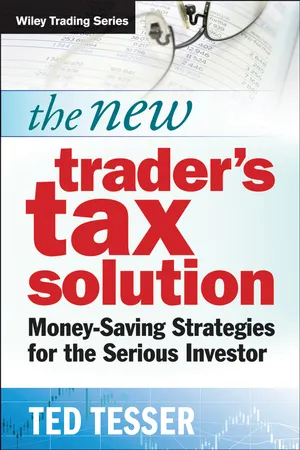
The New Trader's Tax Solution
Money-Saving Strategies for the Serious Investor
- English
- ePUB (mobile friendly)
- Available on iOS & Android
About This Book
The Thoroughly Updated Guide to Reducing Tax Liability for the Trader and Serious Investor
What would you do to increase your trading profits by as much as 50%? Most traders and investors would do whatever it takes. Those same traders will much to often what the profits earned with their blood, sweat and tears shrink considerable as they prepare their tax returns. You have in your hands the easy-to-use tools that will protect your hard earned assets. Packed with proven strategies that reduce your tax exposure this comprehensive guide is completely updated with information and strategies for the most recent tax changes.
Here are invaluable business, estate, retirement planning, and tax-saving strategies that virtually anyone can implement within the new tax laws. It is simple to use and includes specific information to help traders reduce their tax liability, with individual case studies, real-world examples, and model tax returns. CPA and expert tax consultant Ted Tesser provides current solutions for the tax problems facing most U.S. traders, investors, and income earners today-excessive tax payments to federal and local governments, insufficient preparation for retirement, and, ultimately, the fate of bequests. In this book, Tesser shows everyone concerned:
- How to disinherit the federal government
- How Trader Status is upheld, even under audit
- How to augment underfunded retirement plans
- How to master the basiscs of estate tax planning
- How to integrate the "triple crown"-Tesser's latest strategy for tax avoidance and wealth accumulation-into your trading plan and much more.
Keep the profits you work so hard to earn, whether from trading, investing, or hard work-and take control of your financial destiny. The NEW Trader's Tax Solution has puts years of experience at your fingertips.
With the "triple crown, " you will learn how to unleash the full power of Trader Status by combining it with a Trading Entity. You will also learn how to establish a Wlfare Benefit Trust to accomplish all these goals and more. This program enables you to take advantage of little known facets fot he tax law that have been on the books for almost three-quarters of a century. You'll learn how to:
- Contribute and deduct substantial amounts of money over any period of time
- Grow the principle in a fully tax-defered, 100% secure environment
- Access the money at a future date, not limited by age, income, or retirement plan status
- Avoid the restrictions of ordinary retirement plans by using the same techniques that have been used by America's largest corporations since 1928
Whether you are looking for last minute tax saving tips or trading techniques that position you for the optimal tax reduction, The NEW Trader's Tax Solution is a must-have addition to any trading library.
Get the government to pick up the tab on this years trading profits, foot the bill for any trading losses, and increase your wealth by 50%, instantly. After putting Trader Status on the map, Tesser now takes it to another dimension, complete with real world case studies, illustrations, templates, and filled-out, ready to be filed tax forms.
Frequently asked questions
1
The Basics of Accumulating Wealth and Keeping It
THE FOUNDATION—THINGS YOU NEED TO KNOW
THE BASICS OF TAX PLANNING
RED, GRAY, OR BLACK-AND-WHITE? CHOOSE YOUR TAX STRATEGY
THERE IS NO MYSTERY TO SAVING TAXES
THE PARADIGM SHIFT TO TAX F...
Table of contents
- Cover
- Contents
- Title
- Copyright
- Dedication
- Acknowledgments
- Introduction
- Chapter 1: The Basics of Accumulating Wealth and Keeping It
- Chapter 2: The Trader’s Tax Solution
- Chapter 3: Recent Trader Cases
- Chapter 4: The 1997 Trader’s Tax Act—The Most Significant Changes for the Trader and the Investor since 1986
- Chapter 5: The Triple Crown
- Chapter 6: Providing for a Wealthy Retirement
- Chapter 7: They Don’t Make Hearses with Luggage Racks
- Chapter 8: Income and Expenses: A Review
- Chapter 9: New World Retirement Planning
- Chapter 10: New World Estate Planning
- Chapter 11: The Double Play: To Give Is But to Receive!
- Chapter 12: The Layup: It’s Just a Matter of Trust
- Chapter 13: The Home Run: A Way to Double Your Exemptions
- Chapter 14: Modern-Day Miracles—Chalk Up a Few for the Good Guys
- Chapter 15: Knowing Your Limits: How Far Can You Go?
- Chapter 16: 101 Tax-Reduction Strategies
- Appendix A: Investment/Trading Vehicles and How to Report—Tax Consequences
- Appendix B: Deductions Related to Investment and Trading Activities
- Appendix C: The VEBA—Code Sections
- Appendix D: The VEBA—Court Cases
- Appendix E: Other VEBA Rulings
- Appendix F: 166 Frequently Asked Questions and Answers
- Appendix G: Trader Tax Return Examples and the 475 Election
- Appendix H: Logs and Journals
- Appendix I: It’s All a Matter of Time (The Reality of the Wash Sale Rule)
- Appendix J: Trader Evaluation Questionnaire
- Disclaimer
- About the Author
- Index
- Additional Resources